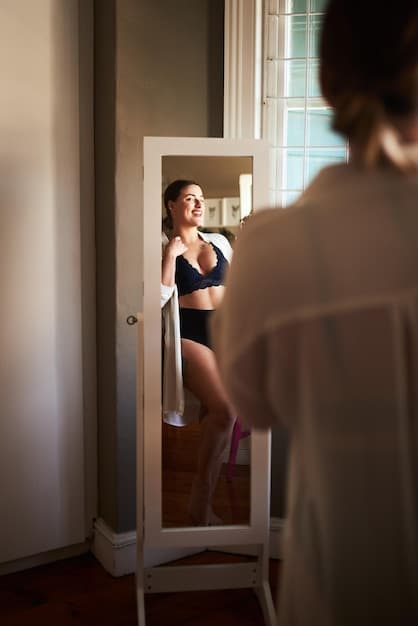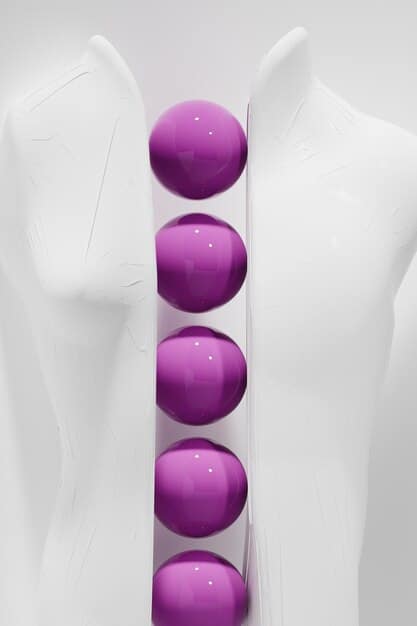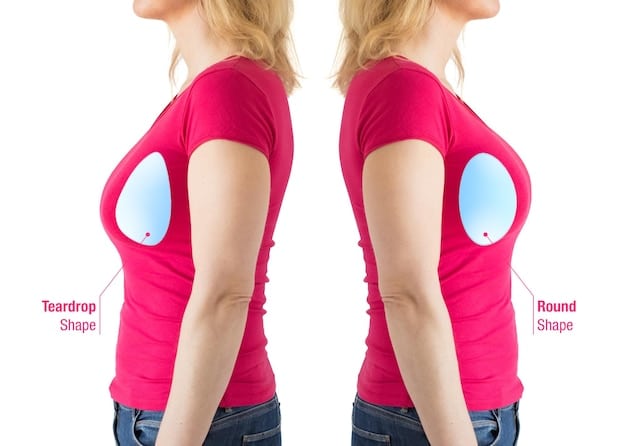Breast Augmentation 2025: Picking the Right Size & Shape

Choosing the right breast implant size and shape for breast augmentation in 2025 involves considering body type, desired aesthetic, and understanding the latest advancements in implant technology to achieve natural-looking results.
Dreaming of a more confident you? Breast Augmentation: Choosing the Right Implant Size and Shape for Your Body Type in 2025 is a journey of self-discovery and enhancement. Let’s explore how to achieve the perfect silhouette with the latest in implant technology and personalized approaches.
Understanding Breast Augmentation in 2025
Breast augmentation has evolved significantly, and in 2025, it’s about more than just increasing size. It’s about achieving a harmonious balance with your body shape and realizing your aesthetic goals.
The advancements in implant technology and surgical techniques mean that women now have more options than ever before, allowing for a truly tailored outcome.
What’s New in Breast Augmentation?
Several factors contribute to the evolution of breast augmentation, making it a more refined and patient-centric procedure.
- Improved Implant Materials: New silicone gel formulations provide a more natural look and feel, reducing the risk of rippling and capsular contracture.
- 3D Imaging Technology: Advanced imaging allows for precise pre-operative planning and virtual simulations, helping patients visualize their potential results.
- Enhanced Surgical Techniques: Minimally invasive approaches lead to smaller scars, faster recovery times, and reduced post-operative discomfort.
Ultimately, the goal of breast augmentation in 2025 is to provide women with a safe, effective, and personalized solution to enhance their natural beauty and confidence.

Factors Influencing Implant Size and Shape
Choosing the right implant size and shape is a collaborative process between you and your surgeon. Several key factors will influence this decision.
Understanding these aspects ensures that the selected implants not only enhance your appearance but also complement your overall physique.
Body Type and Proportions
Your natural body shape and proportions play a crucial role in determining the ideal implant size. A smaller frame may be better suited to smaller implants, while a larger frame can accommodate larger sizes without looking disproportionate. Surgeons often use measurements like shoulder width, chest width, and existing breast tissue to guide their recommendations.
Desired Aesthetic
What kind of look are you hoping to achieve? Do you want a subtle enhancement or a more dramatic transformation? Discussing your aesthetic goals with your surgeon will help them understand your vision and choose implants that align with your desired outcome. Bring photos of breasts that you admire to help illustrate your preferences.
Lifestyle Considerations
Your lifestyle can also impact implant selection. If you’re an athlete, for example, you may prefer smaller, more lightweight implants that won’t interfere with your activities. Similarly, women who prefer wearing certain types of clothing may opt for implant shapes that create a specific silhouette.
By carefully considering these factors, you and your surgeon can work together to choose the implant size and shape that best suits your individual needs and goals.
Understanding Implant Shapes: Round vs. Teardrop
Breast implants come in two primary shapes: round and teardrop. Each shape offers a different aesthetic and may be more suitable for certain body types and desired outcomes.
Understanding the nuances of each shape will empower you to have a more informed discussion with your surgeon.
Round Implants
Round implants are the most common type and offer a symmetrical fullness to the breast. They are a good choice for women who want to enhance the upper part of their breasts and achieve a more youthful, rounded appearance. Because they are the same shape all around, there’s no risk of rotation causing an unnatural look.
Teardrop Implants
Teardrop implants, also known as anatomical implants, mimic the natural slope of a breast, with more volume at the bottom and less at the top. They are designed to create a more natural-looking result, particularly for women with little existing breast tissue. However, there is a small risk of rotation, which could affect the breast’s shape.
- Round Implants: Ideal for enhancing upper pole fullness and creating a more symmetrical appearance.
- Teardrop Implants: Offer a natural-looking slope and are suitable for women with less existing breast tissue.
- Considerations: Rotation risk is minimal with round implants, while aesthetic outcome is more affected if teardrop implants rotate.
Ultimately, the choice between round and teardrop implants depends on your individual preferences and the advice of your surgeon, who will assess your anatomy and aesthetic goals to recommend the best option for you.

Silicone vs. Saline Implants
Besides shape, the material inside the implant is a major consideration. You’ll typically choose between silicone and saline, each having distinct characteristics.
Understanding these differences will help you make an informed decision about which type is best for you.
Silicone Implants
Silicone implants are filled with a cohesive gel that closely resembles natural breast tissue. They tend to feel softer and more natural than saline implants, and many women prefer them for this reason. In the U.S., silicone implants are approved for women aged 22 and older.
Saline Implants
Saline implants are filled with sterile salt water. They are typically inserted empty and then filled to the desired size. If a saline implant ruptures, the saline will be safely absorbed by the body. Some women find that saline implants feel firmer than silicone implants. Saline implants are approved for breast augmentation in women aged 18 and older.
Both silicone and saline implants have their pros and cons. Consider your individual preferences, budget, and health factors when making your choice.
The Role of 3D Imaging in Planning
One of the most exciting advancements in breast augmentation is the use of 3D imaging technology. This allows for more precise planning and better visualization of potential results.
3D imaging plays a pivotal role in ensuring a satisfactory outcome that aligns with your expectations.
How 3D Imaging Works
3D imaging uses a special scanner to create a detailed virtual model of your breasts and chest. This model can then be used to simulate different implant sizes and shapes, allowing you to see how they would look on your body. You can rotate the model, zoom in on specific areas, and compare different options side-by-side.
Benefits of 3D Imaging
3D imaging offers several key benefits:
- Realistic Visualization: See a realistic representation of your potential results before surgery.
- Improved Communication: Communicate your aesthetic goals more clearly to your surgeon.
- Enhanced Decision-Making: Make a more informed decision about implant size and shape.
By taking advantage of 3D imaging, you can feel more confident and prepared going into your breast augmentation procedure.
Recovery and Long-Term Considerations
Breast augmentation is a surgical procedure, and proper recovery is essential for achieving the best possible results. It’s equally important to consider the long-term implications of your decision.
Being well-informed about the recovery process and long-term maintenance will help you manage expectations and ensure lasting satisfaction.
What to Expect During Recovery
After surgery, expect some swelling, bruising, and discomfort. Your surgeon will provide pain medication to manage any pain. You’ll need to wear a surgical bra or compression garment to support your breasts during the healing process. Avoid strenuous activities for several weeks and follow your surgeon’s instructions carefully.
Long-Term Maintenance
Breast implants are not designed to last a lifetime, and you may need to have them replaced at some point. Regular check-ups with your surgeon are essential to monitor the health of your implants. Be aware of the potential risks and complications associated with breast implants, such as capsular contracture, rupture, and changes in nipple sensation.
By understanding the recovery process and long-term considerations, you can approach breast augmentation with realistic expectations and take steps to ensure a positive outcome.
| Key Point | Brief Description |
|---|---|
| 💡 Implant Shape | Round vs. Teardrop shapes offer different aesthetics. |
| 🧪 Implant Material | Silicone and saline implants differ in feel and safety. |
| 🧮 3D Imaging | Helps visualize potential results pre-surgery. |
| ⏳ Recovery | Follow surgeon’s instructions for optimal healing. |
FAQ
▼
Consider your body type, desired aesthetic, and surgeon’s recommendations. 3D imaging can help visualize potential outcomes with different sizes.
▼
Silicone implants often feel more natural and closely resemble breast tissue. Many women prefer them for their soft texture and appearance.
▼
The surgery usually takes one to two hours, depending on the complexity of the procedure and the individual patient’s anatomy.
▼
Risks include capsular contracture, implant rupture, infection, changes in nipple sensation, and the need for additional surgeries.
▼
Regular check-ups with your surgeon are essential, typically annually, to monitor implant health and detect any potential issues early on.
Conclusion
Choosing the right breast implant size and shape is a deeply personal decision. By understanding the different options available, considering your body type and aesthetic goals, and consulting with a qualified surgeon, you can achieve results that enhance your confidence and natural beauty. Stay informed about the latest advancements in breast augmentation to make the best choice for you.





